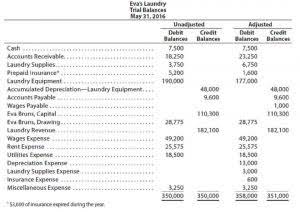
All waste and inefficiencies are identified and reduced as much as possible. All resources (human, material, space, and time) are used to create the highest-quality product while cutting down costs. In traditional inventory management, a business orders large quantities of raw materials, ensuring they have enough to start production immediately when an order comes in. It means making products based on customers’ needs, not just guesses or forecasts. This principle helps manufacturers quickly respond to changes in demand, avoid making too much or storing unnecessary items, and better control their inventory.
- Taiichi Ohno, an industrial engineer at Toyota, developed kanban in an effort to improve manufacturing efficiency.
- That way, you get those yellow goodies at the perfect ripeness, and the store doesn’t toss out heaps of overripe fruit.
- Cassie is a deputy editor collaborating with teams around the world while living in the beautiful hills of Kentucky.
- But it wasn’t always like this, Tesla was small and focused on a niche market—luxury electric cars.
- This includes eliminating variations from the process and for this, standard operating procedures (SOPs) and checklists are developed.
- After assessing waste areas, planning strategically, training the workforce, optimizing physical layouts, and forging solid supplier relationships, the real work begins.
- There are many successful companies that do much better with a Just In Case manufacturing process rather than a Just In Time process.
Production of High Quality
They work closely with suppliers to ensure the timely delivery of fresh and high-quality ingredients, which is critical for the JIT model to work in the fast-food context. Pioneers stepped up to develop ways to lean up their inventory management completely. They built smaller factories that only kept the raw material inventory needed for existing orders. Less capital tied up with carrying inventory allowed these businesses to be more flexible. Apple has only one central warehouse in the US and about 150 key suppliers worldwide; they developed strong and strategic relationships with their vendors. This outsourcing of production made Apple leaner and resulted in slashing costs and reducing overstock.
- This affects products with relatively short shelf life or may go out of style quickly.
- By storing disassembled pieces of furniture, they save huge amounts of space in their warehouses.
- In addition to the automotive industry, technology companies like Dell have utilized JIT manufacturing to maintain their competitive edge.
- Your business can reap many benefits by implementing JIT, but there are also drawbacks that mean it’s not right for everyone.
- So, the best solution for this is to manufacture a variety of products in small quantities.
Why use JIT?
Following this, you should develop a roadmap and outline the steps and timeline for implementation, including any capital investments required for changes in equipment or infrastructure. Another useful method at this time is to conduct benchmarking to measure the current levels of performance and create a baseline just-in-time example for future comparisons. Ben is passionate about International Trade, Import/Export, International Shipping and connecting world markets. For the last 14 years Ben has specialized in importing and exporting goods around the world, and creating software solutions to streamline the import/export process.
Successful Companies Practising Just-In-Time Systems
Toyota, Apple, and McDonald’s are some of the biggest advocates for this inventory system. If you cannot think of a good enough answer for why something is there, then maybe you don’t https://www.bookstime.com/ really need it. The Swedish furniture retailer does a different variation of JIT for years. It doesn’t even assemble the furniture and simply ships parts with instructions.
- The current system needs to be scrapped entirely and rebuilt with a focus on providing value to customers.
- Route4Me’s delivery planning app offers features like electronic signature capture and photo capture for proof of delivery, ensuring transparency and accountability in the just-in-time delivery process.
- To maximize impact, organizations should focus on integrating JIT into a culture of continuous improvement, leveraging responsive technology, and ensuring content relevance.
- As the COVID-19 pandemic showed, JIT processes are highly susceptible to disruptions in the supply chain.
- This flexibility facilitates overcoming bottlenecks and ensuring better customer service.
Just-In-Time with Examples

The origin and history of just-in-time inventory management can be traced back to the late 1900s in Japan. As a result, Japanese industrial engineer “Taichii Ohno” invented this inventory system in the 1970s, wherein raw materials would be appropriately utilized and less wasted. Since just-in-time requires you to start manufacturing only when an order is placed, you need to source your raw materials locally as it will be delivered to your unit much earlier. Also, local sourcing reduces the transportation time and cost which is involved.

Top 6 Tips for a Sustainable Warehouse
This approach not only boosts operational efficiency but also drives overall business success. The supply chain includes different entities such as departments, organizations, workstations in a particular sequence that manufactures and ensures the delivery of products or services. We have found in buying materials that it is not worthwhile to buy for other than immediate needs. We buy only enough to fit into the plan of production, taking into consideration the state of transportation at the time.
JIT Inventory and Supply Chains
Realistic planning and scheduling use the frequency for changing setups for the purpose of managing the material flow and it leads to JIT manufacturing. JIT production is considered for products that have repetitive quality in nature. Analysis tools are arranged and used to improve the workflow and these also help in reducing wasted motion. This step works on the concept in which there should be a place for everything, and everything needs to be kept in its place. There is no value addition to the final product due to few steps such as unnecessary production or processing.
- For example, a company that markets office furniture but does not manufacture it may order the furniture from the manufacturer only when a customer makes a purchase.
- However, the central theme behind just-in-time inventory management is to always keep goods in the warehouses, maintaining low inventory levels that do not cause any wastage.
- You will not make hundreds of your products in advance as you are unsure about future demand.
- As a result, firms can minimize wastage and reduce warehouse costs by producing only necessary goods in response to demand, automatically reducing the holding cost in a just-in-time method.
Just-in-Time Training 2024 – Ultimate Guide for L&D Leaders

What are the Principles of JIT?

Leave a Reply